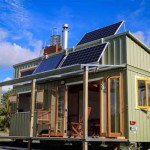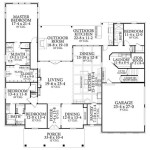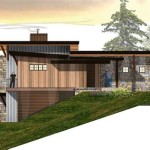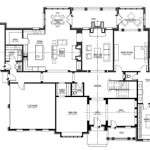Multigenerational house plans are designed to accommodate the needs of multiple generations of a family living under one roof. These plans typically include separate living spaces for each generation, as well as shared spaces for family gatherings. One example of a multigenerational house plan is a home with a main level for the parents, a lower level for the grandparents, and an upper level for the children.
Multigenerational house plans are becoming increasingly popular as more and more families choose to live together. This type of living arrangement can be beneficial for both the older and younger generations. For older adults, it can provide companionship, support, and assistance with daily tasks. For younger generations, it can provide a sense of family history and tradition, as well as a built-in support system.
In the following sections, we will explore the different types of multigenerational house plans, the benefits and challenges of multigenerational living, and how to design a multigenerational home that meets the needs of your family.
Multigenerational house plans offer several advantages, including:
- Stronger family bonds
- Shared responsibilities
- Cost savings
- Emotional support
- Preservation of family history
- Increased safety and security
- Improved quality of life
- Sense of belonging
- Reduced loneliness
Multigenerational living can also present challenges, such as:
- Privacy concerns
- Different lifestyles
- Financial issues
- Space constraints
- Communication difficulties
- Caregiving responsibilities
- Conflict resolution
- Legal and insurance issues
- Estate planning
Stronger family bonds
One of the biggest benefits of multigenerational house plans is that they can help to strengthen family bonds. When multiple generations live together, they have more opportunities to interact and build relationships. This can be especially beneficial for children, who can learn from and bond with their grandparents and other extended family members.
Multigenerational living can also help to reduce isolation and loneliness, especially for older adults. Having family members living nearby can provide them with companionship and support, and it can also give them a sense of purpose and belonging.
In addition, multigenerational living can help to preserve family history and traditions. When older adults live with their children and grandchildren, they can share their stories and experiences, and they can pass on their values and traditions to the younger generations.
Overall, multigenerational house plans can be a great way to strengthen family bonds and create a more supportive and loving environment for all family members.
Shared responsibilities
Another benefit of multigenerational house plans is that they can help to share responsibilities. When multiple generations live together, they can work together to take care of the home and each other.
- Childcare
Grandparents can help to care for their grandchildren, giving parents a break and freeing up time for work or other activities. This can be especially helpful for single parents or parents who work long hours.
- Eldercare
Children and grandchildren can help to care for their elderly parents or grandparents, providing them with assistance with daily tasks, such as cooking, cleaning, and bathing. This can help to keep older adults independent and in their own homes for longer.
- Home maintenance
Everyone in the household can contribute to home maintenance tasks, such as yard work, repairs, and cleaning. This can help to keep the home in good condition and reduce the burden on any one person.
- Financial responsibilities
In some cases, multiple generations may share financial responsibilities, such as mortgage payments or utility bills. This can help to reduce the financial burden on any one person and make it more affordable to live in a multigenerational home.
Overall, sharing responsibilities can be a great way to lighten the load for everyone in the household and create a more equitable and sustainable living arrangement.
Cost savings
Multigenerational house plans can also offer significant cost savings. When multiple generations live together, they can share expenses, such as housing, utilities, and food.
- Housing
The cost of housing is often the biggest expense for families. By sharing a home, multiple generations can reduce their housing costs by splitting the mortgage or rent payments, property taxes, and insurance premiums.
- Utilities
Utilities, such as electricity, gas, and water, can also be shared by multiple generations. This can help to reduce the overall cost of utilities for everyone in the household.
- Food
Food costs can also be reduced when multiple generations live together. Families can buy food in bulk and share meals, which can save money on groceries.
- Other expenses
Other expenses, such as transportation and childcare, can also be shared by multiple generations. For example, grandparents may be able to provide childcare for their grandchildren, which can save parents money on daycare costs.
Overall, multigenerational house plans can offer significant cost savings for families. By sharing expenses, families can reduce their overall cost of living and free up more money for other things, such as education, retirement, or travel.
Emotional support
Multigenerational house plans can provide a strong emotional support system for all family members. When multiple generations live together, they can offer each other companionship, love, and support through good times and bad.
For children, living in a multigenerational home can provide them with a sense of security and stability. They can learn from and bond with their grandparents and other extended family members, and they can always count on someone to be there for them.
For older adults, living in a multigenerational home can help to reduce isolation and loneliness. They can enjoy the company of their children and grandchildren, and they can feel like they are still an important part of the family.
In addition, multigenerational living can help to provide emotional support during difficult times, such as the death of a loved one, a job loss, or a health crisis. Family members can provide each other with comfort and support, and they can help each other to cope with the challenges of life.
Overall, multigenerational house plans can provide a strong emotional support system for all family members. By living together, families can create a close-knit and supportive environment where everyone feels loved and supported.
Preservation of family history
Multigenerational house plans can also help to preserve family history. When multiple generations live together, they can share stories, traditions, and artifacts that tell the story of their family.
For children, living in a multigenerational home can help them to learn about their family’s history and culture. They can hear stories about their grandparents and great-grandparents, and they can see family photos and heirlooms that have been passed down through generations.
For older adults, living in a multigenerational home can help them to pass on their stories and traditions to the younger generations. They can share their memories, their values, and their hopes for the future with their children and grandchildren.
In addition, multigenerational living can help to preserve family artifacts and heirlooms. When multiple generations live together, they can share the responsibility of caring for and preserving these items. This can help to ensure that family heirlooms are passed down to future generations.
Overall, multigenerational house plans can help to preserve family history by providing a place where families can share stories, traditions, and artifacts. By living together, families can create a living legacy that will be passed down to future generations.
Increased safety and security
Multigenerational house plans can provide increased safety and security for all family members. When multiple generations live together, there is always someone at home to keep an eye on the property and the people in it. This can be especially beneficial for older adults, who may be more vulnerable to crime and accidents. In addition, multigenerational living can provide a sense of security and peace of mind for parents, who know that their children are being cared for by trusted family members.
There are a number of specific ways that multigenerational house plans can increase safety and security. For example, many multigenerational homes have separate entrances for each generation, which can help to deter crime. In addition, multigenerational homes often have security features, such as alarms, security cameras, and motion sensor lights, which can further increase safety and security.
In addition to the physical security benefits, multigenerational living can also provide emotional security for all family members. When multiple generations live together, they can support each other through difficult times, such as the death of a loved one, a job loss, or a health crisis. This can help to reduce stress and anxiety for all family members, and it can create a more positive and supportive home environment.
Overall, multigenerational house plans can provide increased safety and security for all family members. By living together, families can create a safe and supportive environment where everyone feels protected and secure.
Improved quality of life
Multigenerational house plans can also lead to an improved quality of life for all family members. When multiple generations live together, they can share resources, experiences, and knowledge, which can benefit everyone in the household.
For children, living in a multigenerational home can provide them with a number of advantages. They can benefit from the wisdom and experience of their grandparents and other older family members, and they can learn about different cultures and traditions. In addition, children who live in multigenerational homes often have stronger bonds with their extended family members, which can lead to a more positive and supportive childhood experience.
For older adults, living in a multigenerational home can help to improve their quality of life in a number of ways. They can benefit from the companionship and support of their children and grandchildren, and they can feel like they are still an important part of the family. In addition, multigenerational living can help to keep older adults active and engaged, which can improve their physical and mental health.
For parents, living in a multigenerational home can provide them with a number of benefits. They can have peace of mind knowing that their children are being cared for by trusted family members, and they can save money on childcare costs. In addition, multigenerational living can help to reduce stress and anxiety for parents, as they know that they have a support system to rely on.
Overall, multigenerational house plans can lead to an improved quality of life for all family members. By living together, families can create a more supportive, loving, and enriching environment for everyone.
Sense of belonging
Multigenerational house plans can also foster a strong sense of belonging for all family members. When multiple generations live together, they create a close-knit community where everyone feels connected and supported.
For children, living in a multigenerational home can help them to develop a strong sense of identity and belonging. They can learn about their family’s history and traditions, and they can feel connected to their extended family members. In addition, children who live in multigenerational homes often have a greater sense of responsibility and empathy, as they learn to care for and respect their elders.
For older adults, living in a multigenerational home can help to reduce feelings of isolation and loneliness. They can enjoy the company of their children and grandchildren, and they can feel like they are still an important part of the family. In addition, multigenerational living can help to keep older adults active and engaged, which can improve their overall well-being.
For parents, living in a multigenerational home can provide them with a sense of peace and security. They know that their children are being cared for by trusted family members, and they can rely on their extended family for support. In addition, multigenerational living can help to reduce stress and anxiety for parents, as they know that they have a support system to rely on.
Overall, multigenerational house plans can foster a strong sense of belonging for all family members. By living together, families can create a close-knit and supportive community where everyone feels loved and connected.
Reduced loneliness
Multigenerational house plans can help to reduce loneliness for all family members, but especially for older adults. As people age, they are more likely to experience loneliness and isolation. This can be due to a number of factors, such as retirement, the death of friends and family members, and decreased mobility. Living in a multigenerational home can help to reduce loneliness for older adults by providing them with companionship and social interaction.
Older adults who live in multigenerational homes have the opportunity to interact with their children, grandchildren, and other family members on a daily basis. This can help to reduce feelings of isolation and loneliness, and it can also provide older adults with a sense of purpose and meaning.
In addition, multigenerational living can help to keep older adults active and engaged. When older adults are involved in the lives of their children and grandchildren, they are more likely to feel connected to the world around them. This can help to improve their overall well-being and reduce their risk of loneliness.
Finally, multigenerational living can provide older adults with a sense of security and belonging. Knowing that they are surrounded by loved ones can help to reduce feelings of loneliness and isolation. In addition, multigenerational living can provide older adults with a sense of purpose and meaning, as they can feel like they are still contributing to the family.
Overall, multigenerational house plans can help to reduce loneliness for all family members, but especially for older adults. By providing companionship, social interaction, and a sense of purpose and belonging, multigenerational living can help to improve the quality of life for older adults and reduce their risk of loneliness.
Privacy concerns
One of the biggest challenges of multigenerational living is managing privacy concerns. When multiple generations live together, it can be difficult to find time and space for privacy. This can be especially challenging for older adults, who may need more privacy and quiet time than younger generations.
There are a number of ways to address privacy concerns in multigenerational house plans. One way is to design the home with separate living spaces for each generation. This can give everyone their own private space to retreat to when they need it. Another way to address privacy concerns is to establish clear rules and boundaries regarding shared spaces. For example, you may want to set aside certain times of the day for quiet time, or you may want to designate certain areas of the home as private spaces for individual family members.
It is also important to communicate openly about privacy needs. Talk to your family members about what they need and expect in terms of privacy. This will help to avoid misunderstandings and conflicts down the road.
Finally, it is important to be respectful of everyone’s privacy. Knock before entering someone’s room, and avoid snooping through their belongings. By respecting each other’s privacy, you can create a more harmonious and comfortable living environment for everyone.
Here are some additional tips for managing privacy concerns in multigenerational house plans:
- Designate certain areas of the home as private spaces for individual family members.
- Establish clear rules and boundaries regarding shared spaces.
- Communicate openly about privacy needs.
- Be respectful of everyone’s privacy.
- Knock before entering someone’s room.
- Avoid snooping through someone’s belongings.
By following these tips, you can help to create a more private and comfortable living environment for everyone in your multigenerational home.
Different lifestyles
One of the biggest challenges of multigenerational living is managing different lifestyles. When multiple generations live together, it can be difficult to accommodate everyone’s needs and preferences. This can be especially challenging if there are significant differences in age, culture, or lifestyle.
For example, older adults may have different sleep schedules, dietary needs, and social activities than younger generations. They may also be more sensitive to noise and activity. Younger generations, on the other hand, may be more active, social, and have different ideas about how to use shared spaces.
Another challenge of multigenerational living is managing different financial situations. Older adults may be on a fixed income, while younger generations may be just starting out in their careers. This can lead to disagreements about how to spend money and how to manage the household budget.
Finally, multigenerational living can also lead to conflicts over household chores and responsibilities. Older adults may be less able to contribute to household chores, while younger generations may have more time and energy to help out. This can lead to resentment and conflict if everyone is not clear about their roles and responsibilities.
Despite these challenges, multigenerational living can be a rewarding experience for all involved. By communicating openly and respecting each other’s needs, families can create a harmonious and supportive living environment for everyone.
Financial issues
One of the biggest challenges of multigenerational living is managing different financial situations. Older adults may be on a fixed income, while younger generations may be just starting out in their careers. This can lead to disagreements about how to spend money and how to manage the household budget.
- Division of expenses
One of the first challenges is deciding how to divide expenses. Should everyone contribute equally, or should expenses be divided based on income or need? If one person is contributing more financially, they may resent the fact that they are not getting as much say in how the money is spent. It is important to have a clear and fair system for dividing expenses to avoid resentment and conflict.
- Saving for the future
Another financial challenge is saving for the future. Older adults may be saving for retirement, while younger generations may be saving for a down payment on a house or their children’s education. It is important to have a plan for saving for the future that takes into account the needs of all generations.
- Estate planning
Multigenerational living can also complicate estate planning. If one person in the household passes away, their assets may need to be divided among multiple generations. This can lead to conflict if there is no clear plan in place.
- Long-term care costs
Finally, multigenerational living can also raise concerns about long-term care costs. If an older adult needs long-term care, who will be responsible for paying for it? This is a difficult question to answer, and it is important to have a plan in place before it becomes an issue.
By communicating openly and planning ahead, families can overcome the financial challenges of multigenerational living. It is important to have a clear understanding of everyone’s financial situation and to develop a plan that works for everyone.
Space constraints
One of the biggest challenges of multigenerational house plans is space constraints. When multiple generations live together, it can be difficult to find enough space for everyone to live comfortably. This can be especially challenging in smaller homes or apartments.
- Bedrooms and bathrooms
One of the biggest space constraints in multigenerational homes is the number of bedrooms and bathrooms. Each generation will need their own private space to sleep and get ready for the day. This can be difficult to accommodate in smaller homes or apartments.
- Living spaces
Another space constraint in multigenerational homes is the amount of living space. Each generation will need their own space to relax and entertain guests. This can be difficult to accommodate in smaller homes or apartments.
- Storage
Multigenerational homes also need a lot of storage space. Each generation will have their own belongings, and it can be difficult to find enough space to store everything. This can be especially challenging in smaller homes or apartments.
- Outdoor space
Finally, multigenerational homes often need outdoor space. Each generation may want their own space to garden, relax, or entertain guests. This can be difficult to accommodate in smaller homes or apartments that do not have a yard.
There are a number of ways to address space constraints in multigenerational house plans. One way is to design the home with a flexible floor plan. This allows the home to be reconfigured to meet the changing needs of the family. Another way to address space constraints is to build a multi-story home. This can provide more space without taking up more land.
Ultimately, the best way to address space constraints in multigenerational house plans is to work with an architect or designer to create a custom plan that meets the specific needs of the family.
Communication difficulties
Communication difficulties are another challenge that can arise in multigenerational house plans. When multiple generations live together, they may have different communication styles, values, and expectations. This can lead to misunderstandings, conflicts, and resentment.
For example, older adults may be more indirect and subtle in their communication, while younger generations may be more direct and assertive. This can lead to misunderstandings and hurt feelings. In addition, older adults may have different values and expectations than younger generations. For example, older adults may value respect for authority, while younger generations may value equality and freedom of expression. This can lead to conflict if these different values are not respected.
Finally, communication difficulties can also arise due to different expectations about how to communicate. For example, older adults may be more comfortable communicating in person, while younger generations may be more comfortable communicating through text or social media. This can lead to frustration and resentment if one generation feels like they are not being heard or understood.
There are a number of ways to address communication difficulties in multigenerational house plans. One way is to establish clear communication rules and expectations. For example, you may want to agree to always communicate respectfully, even if you disagree. You may also want to agree to listen to each other without interrupting. Another way to address communication difficulties is to find ways to communicate that work for everyone. For example, you may want to have regular family meetings where everyone has a chance to share their thoughts and feelings. You may also want to use different communication methods, such as text, email, or social media, to reach different generations.
By communicating openly and respectfully, families can overcome the communication challenges of multigenerational living. It is important to remember that everyone has different communication styles, values, and expectations. By being understanding and patient, families can create a more harmonious and supportive living environment for everyone.
Caregiving responsibilities
One of the biggest challenges of multigenerational living is managing caregiving responsibilities. As older adults age, they may need assistance with activities of daily living, such as bathing, dressing, and eating. This can be a significant burden for younger generations, who may have their own families and careers to care for.
There are a number of ways to manage caregiving responsibilities in multigenerational house plans. One way is to share the responsibilities among family members. This can help to lighten the load for any one person and ensure that the older adult is getting the care they need. Another way to manage caregiving responsibilities is to hire a home health aide or other professional caregiver. This can provide the older adult with the assistance they need while giving family members a break.
It is important to have a plan in place for caregiving responsibilities before they become necessary. This will help to ensure that the older adult is getting the care they need and that family members are not overwhelmed.
Here are some additional tips for managing caregiving responsibilities in multigenerational house plans:
- Communicate openly about caregiving needs. Talk to your family members about what kind of care the older adult needs and how you will share the responsibilities.
- Be realistic about your abilities. Don’t try to do more than you can handle. If you need help, ask for it.
- Take breaks. Caregiving can be stressful. Make sure to take breaks to rest and recharge.
- Seek support from others. There are many resources available to help caregivers. Talk to your doctor, social worker, or other trusted professionals for support.
By working together and planning ahead, families can manage the challenges of caregiving responsibilities in multigenerational house plans.
Conflict resolution
Conflict is a normal part of any family relationship, and multigenerational living can certainly increase the potential for conflict. However, there are a number of things that families can do to resolve conflict peacefully and maintain a harmonious living environment.
One of the most important things is to communicate openly and honestly about your needs and expectations. This means being clear about what you are willing to contribute to the household and what you expect from others. It also means being willing to listen to and understand the needs and expectations of others.
Another important thing is to be respectful of each other’s differences. Everyone has their own unique perspective and experiences, and it is important to value and respect those differences. This does not mean that you have to agree with everything that everyone else says or does, but it does mean that you should be willing to listen and try to understand their point of view.
Finally, it is important to be willing to compromise. Conflict is often the result of two or more people wanting different things. In order to resolve conflict, it is important to be willing to compromise and find a solution that meets the needs of everyone involved.
If you are struggling to resolve conflict on your own, there are a number of resources available to help you. You can talk to a therapist or counselor, or you can attend a family mediation session. These resources can help you to communicate more effectively, understand each other’s perspectives, and find solutions that work for everyone.
By following these tips, families can learn to resolve conflict peacefully and maintain a harmonious living environment.
Legal and insurance issues
Multigenerational house plans can also raise a number of legal and insurance issues. It is important to be aware of these issues before moving into a multigenerational home.
- Ownership and liability
One of the first legal issues to consider is ownership of the home. If multiple generations are living in the home, who owns the property? This can be a complex issue, especially if the home is owned by one generation but another generation is contributing to the mortgage or other expenses. It is important to have a clear agreement in place regarding ownership and liability.
- Zoning and building codes
Another legal issue to consider is zoning and building codes. In some areas, there may be restrictions on the number of unrelated people who can live in a single-family home. It is important to check with your local zoning board to make sure that your multigenerational house plan is compliant with local laws.
- Insurance
Insurance is another important consideration for multigenerational homes. You will need to make sure that your homeowners insurance policy covers all of the occupants of the home. You may also want to consider purchasing additional insurance, such as long-term care insurance or disability insurance, to protect yourself and your family in the event of an accident or illness.
- Estate planning
Finally, it is important to consider estate planning when living in a multigenerational home. You will need to make sure that your will and other estate planning documents reflect your wishes for the disposition of your property after you die. You may also want to consider creating a trust to protect your assets and ensure that your family’s wishes are carried out.
By being aware of these legal and insurance issues, you can help to protect yourself and your family when living in a multigenerational home.
Estate planning
Estate planning is an important consideration for any homeowner, but it is especially important for those living in multigenerational homes. When multiple generations live together, there are a number of potential estate planning issues that need to be addressed, such as:
- Who will inherit the home?
- How will the home be divided among multiple heirs?
- What happens if one of the owners dies before the others?
- How can the home be protected from creditors and other claims?
A well-crafted estate plan can help to address these issues and ensure that your wishes are carried out after your death. One of the most important parts of estate planning is creating a will. A will allows you to specify who will inherit your property and how it will be distributed. You can also use a will to create a trust to manage your assets and protect your family from creditors and other claims.
In addition to a will, you may also want to consider creating a living trust. A living trust is a legal document that allows you to transfer your assets to a trustee, who will manage them for your benefit during your lifetime. After your death, the trustee will distribute your assets according to your wishes.
Living trusts can be a valuable estate planning tool for a number of reasons. First, they can help to avoid probate, which is the legal process of administering a will after someone dies. Probate can be a time-consuming and expensive process, and it can also expose your assets to creditors and other claims. Second, living trusts can help to protect your assets from creditors and other claims, even after your death.
If you are considering creating a multigenerational house plan, it is important to speak to an estate planning attorney to discuss your options and create a plan that meets your needs.










Related Posts








